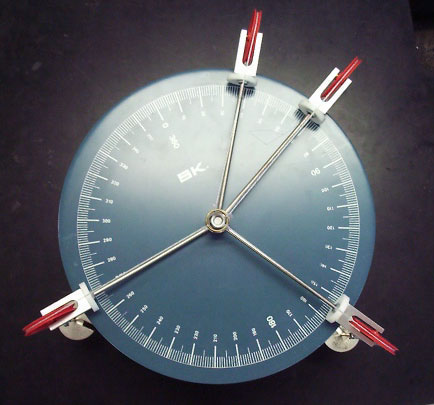|
|
|
Chapter 6
Force Vector Lab
|
|
|
|
|
|
|
Problem: Prove, using vector analysis, that when an object which has multiple forces on it doesn’t accelerate, the net force on the object is zero.
Hypothesis: You write your own. Your hypothesis should refer to the provisions of Newton's Second Law.
|
|
|
|
You are to set up an equilibrium situation with a force table and several masses to provide force as shown below. Your task is to demonstrate that the net force on a stationary object is zero. You will conduct sevaral trials as instructed. Your lab instructions delineate the requirements for your lab report.
Materials: Force table apparatus with 4 pullies connected to a center brass ring
A set of slotted masses with hangars
|
|
|
|
 |
|
|
|
Set up the force table as shown, with masses hanging from each of the pulleys. The masses should all be different. Multiple slotted masses can hang from each pulley to accomplish this. Don't forget to add the mass of the 'hanger'. |
|
|
|
Make certain that the legs of the force table are balanced such that the surface of the table is level. |
|
|
 |
Looking directly over the top of the force table, adjust all the pulleys so that the center ring on the mass remains stationary directly over the center of the force table. Arrange them such that no two pulleys (forces) are perpendicular to each other! The weight on the strings will be redirected by the pulleys so that they are pulling outward from the center. If the center ring is not moving, what does this tell you about the forces acting on it? |
|
|
|
Determine the vector values (magnitude and direction) of each of the forces acting on the ring. Using vector addition, find the net force acting on the center ring. Barring friction, what SHOULD the net force be? If the net force doesn't work out to zero, what might be supplying the 'equilibrant' force?
Repeat the experiment with different forces as indicated on your handout.
|
|
|
|
 |
|
|
|
|
|
|
|
|
|
|
|
|
|
|
|
|
|
|
|


